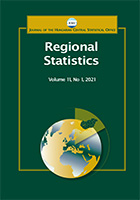Analysis of community resilience in Hungary – An adaptation of the basic resilience indicators for communities (BRIC), 2020
Analysis of community resilience in Hungary – An adaptation of the basic resilience indicators for communities (BRIC), 2020
Author(s): Anna Csizovszky, Attila BuzásiSubject(s): Social Sciences, Economy, Geography, Regional studies
Published by: Központi Statisztikai Hivatal
Keywords: community resilience; spatial autocorrelation; BRIC; regional pattern
Summary/Abstract: Currently, resilience studies are at the forefront of urban and regional research. However, community resilience is generally less investigated than economic or climate resilience. Community resilience, defined as the ability of different regional levels to adjust their socioeconomic systems to cope with adverse effects of external factors and to be able to provide adaptive responses, plays a crucial role in sustainable regional development patterns. This paper addresses this scientific gap in the general lack of community resilience studies in Hungary and the understudied regional focus. The study has two aims: 1) to collect statistical variables for assessing community resilience based on the basic resilience indicators for communities (BRIC) framework and 2) to conduct statistical and regional analyses at the Hungarian subregional level (former LAU level 1). The subregional level provides an extensive amount of spatial units that enabled the authors to apply context-specific indicators and reveal regional patterns. The authors conducted several statistical analyses, proving the independence of the selected variables and the effectiveness of the elaborated community resilience index. Regarding regional characteristics, the authors mapped and analyzed the spatial pattern of each community resilience dimension and the overall index. Furthermore, this paper evaluated spatial autocorrelation aspects to identify those areas where similar subregions can be found. The applied statistical analyses regarding the elaborated set of indicators prove the relatively high independence of variables. Although the Pearson correlation was found to be significant in some cases, there were no professional connections. Regarding the multicollinearity analysis, the authors found that the variance inflation factor (VIF) values of the dimensions do not exceed the benchmark value of 5. The regional analyses showed high heterogeneity concerning the evaluated resilience category. In the cases of infrastructure, community, and environmen-tal dimensions, rapidly urbanized subregions and their agglomerations had lower values. The economic and social aspects proved the east‒west axis within the country, and the below-average values well followed the average size of municipalities within the sub-regions. Finally, the Central-Northern sub-regions are spatially correlated, defining a regional hotspot with below-average perfor-mances by paying attention to the calculated Moran’s I values.
Journal: Regional Statistics
- Issue Year: 13/2023
- Issue No: 04
- Page Range: 752-778
- Page Count: 27
- Language: English

